Meeting different requirements in falsework and formwork
06 October 2022
Infrastructure projects can require extremely challenging structures and the formwork and falsework industry needs to continually adapt to meet these obstacles. Buildings are getting taller, more complex, and tasked with increasingly strict environmental targets. Put simply, the falsework and formwork industry has to keep up to date with the evolving demands of the built environment.
There isn’t a shortage of new projects and there is much to admire about the innovative ways companies are finding to meet the differing needs of all their clients.
Falling materials, tools, or debris are a considerable risk on construction sites and every project will have different requirements to mitigate these issues. Paschal says that they recognise that safety requirements differ around the world, as well as from project to project, and so provide three different safety sets.
What is Falsework and Formwork?
Formwork means the surface of the form and framing used to contain and shape wet concrete until it is self-supporting. Formwork includes the forms on or within which the concrete is poured and the frames and bracing which provide stability. Although commonly referred to as part of the formwork assembly, the joists, bearers, bracing, foundations and footings are technically referred to as falsework.
Falsework means the temporary structure used to support a permanent structure, material, plant, equipment and people until the construction of the permanent structure has advanced to the stage where it is self-supporting. Falsework includes the foundations, footings and all structural members supporting the permanent structural elements. Falsework can be used to support formwork for in-situ concrete, prefabricated concrete elements, steel sections or stone arches, for example during bridge construction.
Safety on construction sites
Marius Wunder, managing director at Paschal, says, “In many markets, new regulation forces our customers to invest in health and safety components for their systems.
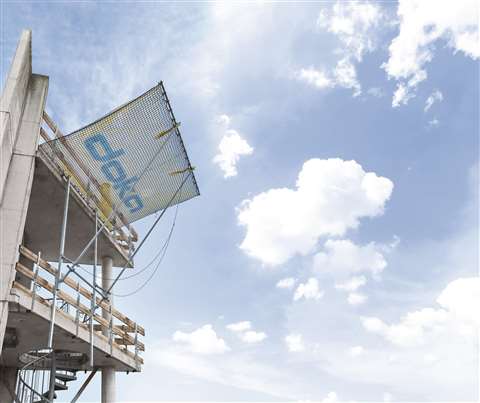 Doka’s Xsafe Catch Fan (Photo: Doka)
Doka’s Xsafe Catch Fan (Photo: Doka)
“We are working in all regions to archive industry subsidies for the clients who invest in our health and safety equipment.”
Also enhancing safety on site, Doka’s Xsafe Catch Fan system comprises pre-assembled units that can be used on any structure and adapted to any shape. The company says that the vertical extensions of the Xsafe Catch Fan are specifically designed to meet individual project requirements.
The Xsafe Catch Fan can be assembled on the ground, easily lifted, and quickly re-positioned from floor to floor without adjustment to the vertical extensions.
Thomas Lattacher, product manager, Doka, says, “With the development of the Xsafe Catch Fan, we identified the potential to provide more safety on construction sites. Customers benefit from efficient and simple workflows, allowing them to focus fully on the essentials of day-to-day construction site operations.”
Bauma 2022 will see the launch of new products and services from companies across the globe, including Paschal’s new NeoR Lightweight Formwork. Wunder adds, “I’m thrilled to present our new NeoR Lightweight Formwork. Paschal’s historic success was built on the previous lightweight system called Raster. We are now offering a system that is lighter, faster to install, and carries more concrete pressure.”
Paschal says that the NeoR multi-purpose panels can be stacked to adjust the height of the formwork to the required concreting height. The horizontal connection at the panel joints is made with the key bolt. In this way, column formwork with different dimensions can be erected in less time with just a few lightweight panels.
Advances in construction technology
The use of technology in the falsework and formwork industry is rapidly expanding. Wunder says that digital planning has become a critical success factor.
“Nowadays, this is combined with augmented reality (AR) solutions like the Paschal AR-App. Augmented reality is a perfect way to eliminate the negative impact of missing information in reality and from the abstractness of the drawings,” he says.
The AR app is said to make it possible to present the planned formwork solution in original size on an area in real surroundings by means of a smartphone or tablet. The AR interface is said to improve consistency from the 3D formwork model across all process steps through to the construction site.
This suggests that technology has a place within the industry to ensure that risks are mitigated, and information is easy to comprehend, no matter the skill level.
Peri SE and Sika AG are also embracing technology; they have partnered up to take a stake in a Swiss start-up that has developed what is said to be the world’s first robot-assisted technology for the cost-effective production of complex reinforced concrete structures without formwork.
Mesh AG has developed ‘MESH Technology’ which, according to the company, makes it possible to produce complex or curved reinforcement cages, previously manufactured by laborious manual work, through an automated prefabrication process.
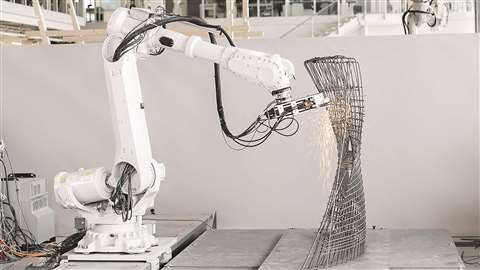 Peri and Sika participate in the development of Mesg AG (Photo: Peri)
Peri and Sika participate in the development of Mesg AG (Photo: Peri)
A 3D steel-mesh structure created this way serves as both formwork and reinforcement and is filled by a specific concrete mix without using conventional formwork.
The technology can be used for customised concrete structures, for the production of complex forms for the building industry and to structurally optimise conventional concrete structures.
Despite being an industry that is renowned for its slow adoption of technology, companies are steadily changing their ways. In Europe, the south end of the Frankfurt Airport Terminal 3 project in Germany has also incorporated digital methods into its site practice.
One of Europe’s largest infrastructure projects, Peri was tasked with designing a 40m long, 25m wide and up to 12m high custom formwork carriage.
The project took a partly digital approach and provided QR codes that could be scanned to open short video sequences that explained the work steps in detail. The digital operating manual system was developed to condense the 1,500 page structural calculations document.
Sustainability
Sustainability is a driving factor in the future of construction and Paschal’s Wunder confirms that it is an increasing focus. “Sustainability will continue to be a key driver behind many activities of the sector for the decades to come,” he comments.
“Paschal has a designated commitment to sustainability. We show this in the quality of our metal frames that can be used for 36 years or longer as well as also sticking to wood-based plywood.”
As government-led sustainability initiatives and environmental regulations become an increasing priority, many companies are beginning to see the potential of modular systems. Ulma has entered this market with Onadek – a system that can be adapted to suit any geometry and meet the needs of any application and infilling.
The company says that Onadek was created due to an increase in demand for single formwork that could be both modular and flexible. As the industry moves steadily towards sustainable alternatives, Ulma says that this signifies a new era for formwork. Resources are saved in the long term whilst there is an even higher degree of reusability.
What is Europe’s longest suspension bridge?
Falsework and formwork companies are tasked with some of the most intricate and complex projects, which all require innovative solutions. Spanning a total of 2,400m, Croatia’s Pelješac Bridge is the second longest suspension bridge in Europe. Europe’s longest suspension bridge is the The Vasco da Gama Bridge in Portugal.
Construction on the bridge in Croatia began back in 2018 and was officially opened to the public this year. Doka was tasked with providing the necessary infrastructure to facilitate the construction of the concrete pylon structures and the load-bearing parts. Due to the complex nature of the project, Doka says that several formwork systems needed to be deployed, some of which had to be custom-made specifically for the project.
The construction of pylons rising directly out of the sea was challenging, says Doka, necessitating the use of self-climbing systems for installation. In addition to the construction challenges, the whole area was located in a high seismic activity zone and is renowned for its strong winds.
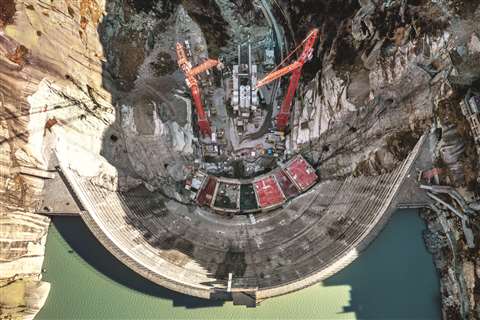 The 1,900m high alpine construction site presents a demanding work environment
The 1,900m high alpine construction site presents a demanding work environment
The company says that the Doka Xclimb 60 hydraulic climbing system was chosen to reduce the difficulty while ensuring the safest implementation. The project set the concrete lifting height at 4.5m for the lower part of the pylons and 4.0m for the upper parts.
Doka is working on numerous projects, including as the principal supplier to the new Spitallamm dam project at Lake Grimsel in the Swiss Alps. The project necessitates the creation of customised components under extremely challenging conditions.
The new double curvature dam will require pouring more than 220,000 cubic metres of concrete, supported by Doka formwork. On completion in 2025, Doka’s customised solutions will have contributed to renewable energy sources supplying more than one million people with sustainable energy.
Robert Hauser, CEO of Doka, says, “Hydropower plants enable largely CO2-free energy generation. With the construction of the new Spitallamm dam, we are working on a project that will secure green electricity in Switzerland in the long term.”
Over in Hong Kong, Altrad RMD Kwikform took part in the build of the Immigration Headquarters. The new building complex will cover a total construction floor area of 139,327m2 and provide general office accommodation and frontline immigration services for the public.
Altrad RMD Kwikform provided the 17-storey project with its new R800 heavy-duty girder system to help support the construction of two sky bridges connecting the 8th and 14th floors.
Buildings are becoming taller and complex styles demand innovative falsework and formwork solutions. The company says that the R800 enables long lattice girders to be assembled quickly and safely, and so was ideally suited to build the Immigration Headquarters’ new sky bridges w leaving clear working room below.
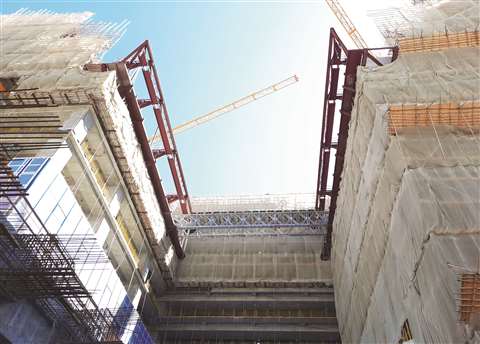 Work on the Immigration Centre in Hong Kong (Photo: Altrad RMD Kwikform)
Work on the Immigration Centre in Hong Kong (Photo: Altrad RMD Kwikform)
Peter Atkinson, business development manager for groundworks at Altrad RMD Kwikform, says, “When compared with alternative solutions, the lightweight nature of the R800 system means it’s easy to assemble and transport.
“If the R800 system had not been used, large structural beams would have been required, which would have taken longer to install and cost our client more as well. The R800 system also underwent proof load testing prior to being used, in order to demonstrate its capabilities to the Hong Kong authorities.”
After its launch in March of this year, Altrad RMD Kwikform says that the R800 is ideally suited to simply supported, continuous/multi-span, cantilever or launched falsework, and vehicle, pedestrian, and service bridging.
As projects become more ambitious and new challenges arise, it is evident that a ‘one size fits all’ approach will not support the level of innovation within the industry. It is therefore essential that falsework and formwork companies continue to develop their products whilst ensuring the safety of all of those who use them.
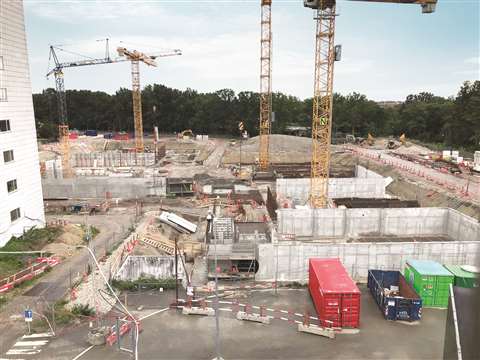 (Photo: Meva)
(Photo: Meva)
Meva says that the construction of the walls had to have a series of cast-in columns. The columns each had to support precast concrete beams, which were installed afterwards, and the distance varied from column to column.
This is said to have made the design and casting more challenging than usual because everything had to fit together. The job was solved by combining AluStar and StarTec formwork with Meva supplying over 1,000m² of formwork for the external walls throughout the rehabilitation building.
In the complex, where three of the buildings extend from the basement level all the way up to the 5th floor, cores with elevators and staircases also had to be cast. The cores had to be relatively small, and it was necessary to strip the inside using stripping corners.
In this way, Meva says that the entire inner core could be lifted out and quickly moved on to the next casting.
The external part of the core was reported to have been the most complicated because a series of relief beams resembling noses had to be cast into the core structure and supported with formwork.
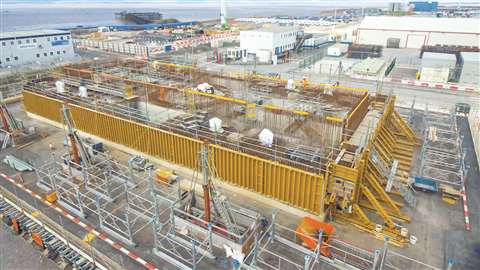 Formwork on the Hinkley Point C nuclear power site
Formwork on the Hinkley Point C nuclear power site
The UK-based company will provide formwork solutions and onsite support to create structures totalling 10,000 cubic meters of concrete poured at the site in Bristol, UK.
The four inlet and two outfall tunnels are being constructed under the sea. The heads will connect to the end of the 23’ diameter tunnels and funnel seawater to two nuclear reactors. With each head weighing up to 6,065 tons and a projected 60-year lifespan on the seabed, the process for construction and tolerances are at Class 1 nuclear level, which is rarely seen.
The concrete inlet and outfall heads are subject to a challenging environment. Any defect in the concrete can cause seawater to reach and degrade the rebar causing the structure to fail and not perform to the required parameters.
The company faced the challenge of designing the formwork to support the weight of the cast concrete without any internal ties that could potentially weaken the structure.
EFCO UK provided a formwork solution that combined ring compression and internal bracing to restrain the shaft and void formers, which externally anchors Super Stud A-frames, and bracing. The company says this approach eliminated the need for through ties in the formwork.
STAY CONNECTED



Receive the information you need when you need it through our world-leading magazines, newsletters and daily briefings.
CONNECT WITH THE TEAM








